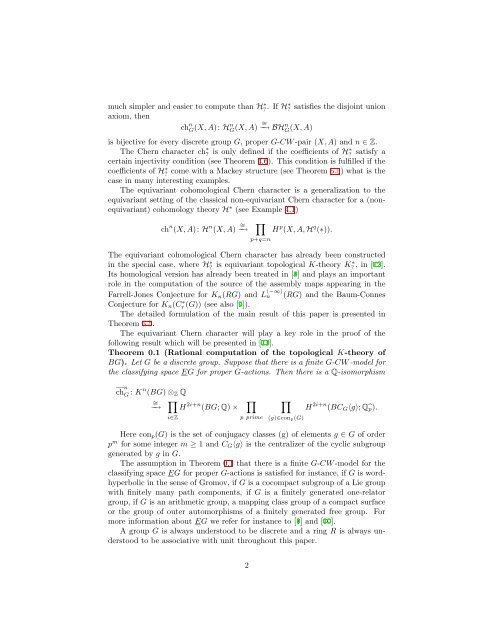Equivariant Cohomological Chern Characters
Equivariant Cohomological Chern Characters
Equivariant Cohomological Chern Characters
Create successful ePaper yourself
Turn your PDF publications into a flip-book with our unique Google optimized e-Paper software.
much simpler and easier to compute than H? ∗ . If H∗ ?satisfies the disjoint unionaxiom, thench n G(X, A): HG(X, n A) −→ ∼= BHG(X, n A)is bijective for every discrete group G, proper G-CW -pair (X, A) and n ∈ Z.The <strong>Chern</strong> character ch ∗ ? is only defined if the coefficients of H? ∗ satisfy acertain injectivity condition (see Theorem 4.6). This condition is fulfilled if thecoefficients of H? ∗ come with a Mackey structure (see Theorem 5.5) what is thecase in many interesting examples.The equivariant cohomological <strong>Chern</strong> character is a generalization to theequivariant setting of the classical non-equivariant <strong>Chern</strong> character for a (nonequivariant)cohomology theory H ∗ (see Example 4.1)ch n (X, A): H n (X, A) ∼= −→∏p+q=nH p (X, A, H q (∗)).The equivariant cohomological <strong>Chern</strong> character has already been constructedin the special case, where H? ∗ is equivariant topological K-theory K∗ ?, in [12].Its homological version has already been treated in [8] and plays an importantrole in the computation of the source of the assembly maps appearing in theFarrell-Jones Conjecture for K n (RG) and L 〈−∞〉n (RG) and the Baum-ConnesConjecture for K n (Cr ∗ (G)) (see also [9]).The detailed formulation of the main result of this paper is presented inTheorem 5.5.The equivariant <strong>Chern</strong> character will play a key role in the proof of thefollowing result which will be presented in [11].Theorem 0.1 (Rational computation of the topological K-theory ofBG). Let G be a discrete group. Suppose that there is a finite G-CW -model forthe classifying space EG for proper G-actions. Then there is a Q-isomorphismch n G : K n (BG) ⊗ Z Q∼ =−→ ∏ i∈ZH 2i+n (BG; Q) × ∏p prime∏(g)∈con p(G)H 2i+n (BC G 〈g〉; Q̂p).Here con p (G) is the set of conjugacy classes (g) of elements g ∈ G of orderp m for some integer m ≥ 1 and C G 〈g〉 is the centralizer of the cyclic subgroupgenerated by g in G.The assumption in Theorem 0.1 that there is a finite G-CW -model for theclassifying space EG for proper G-actions is satisfied for instance, if G is wordhyperbolicin the sense of Gromov, if G is a cocompact subgroup of a Lie groupwith finitely many path components, if G is a finitely generated one-relatorgroup, if G is an arithmetic group, a mapping class group of a compact surfaceor the group of outer automorphisms of a finitely generated free group. Formore information about EG we refer for instance to [1] and [10].A group G is always understood to be discrete and a ring R is always understoodto be associative with unit throughout this paper.2
















